-
January 1989
First Pathfinder balloons launched in Antarctica
During its second expedition to Antarctica in November 1989, the Air Force Geophysics Laboratory (AFGL) tested a special type of balloon denominated Pathfinder. The objective of the experiment was to gain further knowledge about the Antarctic stratosphere and balloon behavior in that environment.
-
January 2 1903
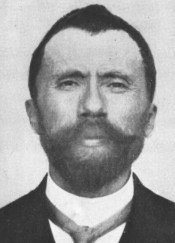
Léon-Philippe Teisserenc de Bort dies
On this day in 1903, Léon-Philippe Teisserenc de Bort a French meteorologist who discovered the stratosphere in 1902, died in Cannes, France at the age of 57.
He had established his own observatory at Trappes in 1896 and pioneered in the use of unmanned, instrumented balloons to investigate the atmosphere.
Teisserenc de Bort found that above an altitude of 7 miles (11 km) temperature ceased to fall and sometimes increased slightly. He named this upper part of the atmosphere the stratosphere, because he thought that the different gases would lie in distinct strata as, without temperature differentials, there would be no mechanism to disturb them. The lower part of the atmosphere he named the troposphere (Greek for "sphere of change") as here, with abundant temperature differentials, constant change and mingling of atmospheric gases occurred. -
January 4 2001
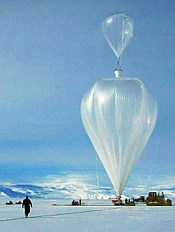
Antarctic flight of TopHat experiment
On this day was launched from McMurdo Station in Antarctica TopHat, an innovative instrument designed to measure the Cosmic Microwave Background Radiation (CMBR) anisotropy on angular scales. It was a development of NASA's Goddard Space Flight Center, the University of Chicago, the University of Wisconsin-Madison and the Danish Space Research Institute.
It was composed of two main elements, a spinning one-meter telescope optimized to reject both systematic and foreground spurious signals by placing it on top of the balloon, instead below, and a detector system composed by a radiometer using bolometric detectors operating at ~250mK. The telescope simply spun at a constant rate about its vertical axis and as the Earth rotated, this entire sky was observed each day. A secondary payload at the bottom of the balloon provided the power and computer support for the top payload, including the hard disks on which the information was stored.
The balloon of 29.47 million cubic feet flew 37 km high for 26 days and 20 hours around the white continent, ending its mission on January 31. The mission exceeded in 44 hours the previous duration record for a zero pressure balloon. -
January 6 1964
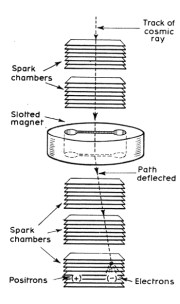
First evidence of Positrons in primary Cosmic Rays
On this day in 1964, was published in the Physical Review Letters (Vol. 12 Nº 1) an article suggesting that evidence was obtained to support the theory that supernovae are a source of electrons in cosmic rays reaching vicinity of earth.
The experiment, which was transported to the stratosphere by a high altitude balloon, consisted of a permanent magnet and two pairs of spark chambers above and below coupled to a cerenkov counter telescope. Two flights were performed in the summer of 1963 from Ft. Churchill, Manitoba, Canada under Navy's Skyhook balloon program by physicists of the University of Chicago and the Argonne National Laboratory.
In both missions the detector collected more than 62.000 cosmic ray events in 22 hours of flight.
The analysis of the data revealed that primary cosmic rays in earth's upper atmosphere contained average of three times as many electrons as positrons. -
January 7 1785
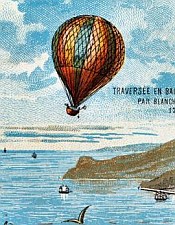
First balloon flight from England to France over the English Channel
On this day in 1785, Frenchman Jean Pierre Blanchard and American scientist and physician John Jeffries made the first air crossing from Dover, England to Guines in France, flying over the English Channel in a hot-air balloon - the first international flight. This was the second of two balloon flights that Jeffries financed. To accompany him, Jeffries chose Blanchard for his prior experience in balloon flight.
The voyage across the Channel was successful, though not without difficulty. At first, their sojourn went well as the wind carried them eastward. Once over the Channel, however, the balloon lost altitude and the pair began tossing ballast overboard to remain aloft. By the time they were two-thirds of the way across, all their ballast was gone, so they began tossing everything in the gondola they possibly could, even their clothes. About two hours after take off, they crossed the French coast clad only in their underwear and the cork life jackets they brought in case they landed in the water.
Once they cleared the coast line they continued inland for another half-hour. Blanchard finally landed the balloon in a small clearing near Guines, France, where today stands a monolith commemorating the feat. -
January 7 1948
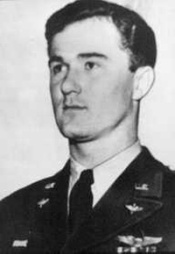
The Mantell incident
On this day in 1948, Captain Thomas F. Mantell, a WWII veteran pilot, crashed while pursuing an unidentified flying object near Fort Knox, Kentucky. After personnel at Godman Army Airfield reported seeing a large circular object, Mantell and three other pilots were asked to investigate. While two planes turned back due to low fuel, Mantell continued the chase, reporting something "metallic and tremendous in size" before his F-51 Mustang crashed, killing him.
The Air Force later concluded he had been pursuing a high-altitude Skyhook balloon launched from Camp Ripley, Minnesota on January 6th, and crashed due to oxygen deprivation, as his plane wasn't equipped for high-altitude flight.
The incident became one of the most famous early UFO cases and the first fatality associated with UFO sightings in U.S. history. -
January 7 2014
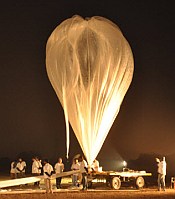
First balloon entering the mesosphere in India
On this day in 2014, the Tata Institute of Fundamental Research (TIFR), launched from the National Balloon Facility, in Hyderabad a balloon which penetrated into the Mesosphere for the first time in India.
The 61.000 cubic meter balloon was manufactured at TIFR Balloon Facility using a ultra-thin polyethylene film developed in India measuring 3.8 micro meters thick. The technological payload wighed 7.9 kilograms and included sensors, a timer, radio communication / telecommand devices, ATC Transponder, GPS and upward looking video cameras.
The balloon was launched at 4:02 Indian Standard Time on January 7th 2014, reaching the record setting altitude of 51.661 kilometers at 6:11 IST. The flight was terminated at 7:04 IST and the payload was recovered near Husnabad, in Andhra Pradesh. -
January 8 1988
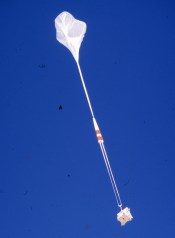
First flight of a big stratospheric balloon in Antarctica
On this day in 1988, was launched from Williams Field, one of the airports that serves the McMurdo station, the first large stratospheric balloon that has been flown in Antarctica. The objective of the flight was to transport a Gamma Ray Spectrometer called GRAD (Gamma Ray Advanced Detector) developed by the University of Florida, NASA's Goddard Space Flight Center and the Defense Advanced Research Projects Agency.
GRAD was originally scheduled to fly on a space shuttle mission in 1987, but was shelved after the Challenger disaster in January of that year. The instrument had already been built, tested and fully qualified for space flight when the SN1987A supernova was discovered in the southern hemisphere sky. Therefore, to take advantage of the opportunity to make observations of this phenomenon, it was decided to adapt GRAD to a balloon platform and launch it over the white continent with the support of the National Science Foundation and the balloon launch group of the Holloman Air Force Base in New Mexico.
The mission lasted just three days out of the fifteen or twenty originally planned due to a failure in the instrument's power system. During the flight, GRAD detected gamma ray lines from SN1987A associated to the 847 kev and 1238 kev transitions in FE(56) from the radioactive decay of CO(56). Also anisotropic features in the background were detected.
The mission was the first launch of a large, zero-pressure, high-volume balloon in Antarctica and also served as a demonstration that long-term circumpolar flights were feasible during the summer, paving the way for a future balloon program. -
January 9 1793
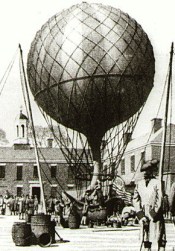
First Air Voyage in America by Jean Pierre Blanchard
On this day, in 1793 the French aeronaut Jean Pierre Blanchard performed the first aerial voyage in America using a hot air balloon that flew from Philadelphia to New Jersey. Among the multitude that witnessed the ascent that day was President George Washington, and the future presidents John Adams, Thomas Jefferson, James Madison, and James Monroe.
With a load of food, wine, meteorological instruments, a tiny black dog and Blanchard as pilot the balloon was released from the yard of the Walnut Street Prison, in Philadelphia, Pennsylvania around 10 AM. As he ascended, Blanchard was "astonished" at the "immense number of people, which covered the open places, the roofs of the houses, the steeples, the streets, and the roads, over which my flight carried me in the free space of the air."
The balloon took a mostly southward direction. Over the Delaware River, he reached the highest point of the flight; 5,812 feet, as measured with a barometer he carried with him. During the sort flight Blanchard collected six bottles with air samples, controlled his pulse rate and attempted to see if the flight had any effect on the magnetic properties of a lodestone he carried.
After some eating and drinking, he decided to land on the New Jersey side of the Delaware River, but during the descent the balloon was headed toward a densely wooded area, so Blanchard released some ballast to regain altitude. On the third attempt, he finally landed in Deptford Township, New Jersey, at 10:56 AM. He'd traveled about fifteen miles in little less than an hour. -
January 10 1956
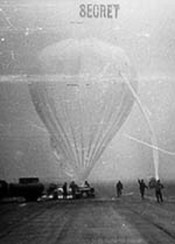
Start of the GENETRIX spy balloon launches towards the USSR
On this day in 1956, the first wave of GENETRIX spy balloons were sent from Germany and Turkey towards the Soviet Union beginning one of the most secret programs of the cold war. GENETRIX was the code name of a cover program carried out by the United States Strategic Air Command (SAC) and other agencies to obtain photographic and electronic reconnaissance of the URSS and its allies using stratospheric balloons. That day, eight balloons were launched from the Adana air base in Turkey and one from the Giebelstadt airfield in Germany. Three other sites soon joined the offensive: Oberpfaffenhoffen (Germany) and Evanton (Scotland) on January 11 and Gardermoen (Norway) two days later.
The balloons moved through the Soviet Union in the winter jet stream, covering almost all of its territory. Once out of Russian airspace, the gondolas were separated from the balloons by radio signals and, while parachuting, were caught in the air or recovered from the water by specially equipped aircraft.
Although the operation was planned to last until June, after some strong protests by Soviet diplomacy that included the public display of downed balloons and cameras, GENETRIX ended after only 27 days of operation. Of 516 balloons launched, only 44 payloads were recovered plus another three that were found in Alaska, Iceland and Canada in the following months and years. -
January 11 1967
French balloon found in North Carolina, United States
On this day, the remains of a high altitude research balloon that was launched by CNES from Aire Sur L'Adour in southwest France were found 10 miles south of Burlington, North Carolina, in the United States. The balloon was launched on january 5 and remained flying around 130.000 ft during two or three days. After crossing China the last contact the agency had with it was over Mongolia. The balloon crossed the Pacific and the United States before came to rest in a tree near US east coast. The objective of the flight was technological carrying a payload composed by radio transmitter, barometer, and a device for measuring the angle of the sun above the horizon.
-
January 21 2021
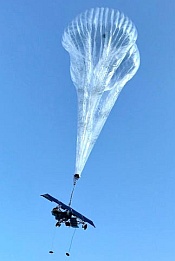
Project Loon announces the end of operations
On this day in 2021, Google announced the shutdown of Project Loon, ending its nine-year effort to provide wireless connectivity via high-altitude balloons. Despite achieving technical success and beginning commercial service in Kenya in 2020, covering nearly 50,000 square kilometers with 35 balloons, the project couldn't achieve financial viability.
Loon, a project that started back in 2011 and became public in 2013, was spun off from Google's parent company Alphabet in 2018 and raised $125 million from SoftBank in 2019, but struggled to secure additional funding.
The project that utilized balloons as high-altitude cell towers to provide LTE connectivity and had partnerships with satellite companies like SES and Telesat, was a pioneering effort in the field of balloon maneuverability, achieving for the first time in history a relatively cheap technology that allowed a balloon to be driven from one point to another. -
January 25 1964
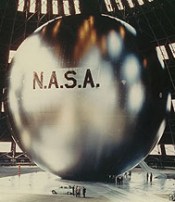
ECHO II balloon-satellite launch
On this day in 1964 was put in orbit Echo 2, the second and last balloon-satellite -also known as "satelloon"- of NASA's Project Echo. The craft was launched on a Thor Agena rocket from the Vandenberg AFB in California.
The satellite had a diameter of 135 feet and was manufactured by Bell Labs using aluminum foil laminated with mylar. It was designed as a rigidized passive communications spacecraft for testing propagation, tracking, and communication techniques. The instrumentation it carried included a beacon telemetry system that provided a tracking signal, sensors to monitor the spacecraft skin temperature, and a system to measur its internal pressure, especially during the initial inflation stages. In addition to fulfilling its communications mission, Echo 2 was used for global geometric geodesy.
Orbiting in a near polar orbit, it was conspicuously visible to the unaided eye over all of the Earth. Finally on June 7, 1969 after more than five years in orbit, the balloon re-entered the atmosphere and burned up. -
January 25 1974
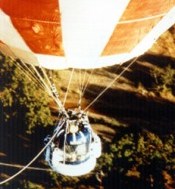
New altitude record in hot-air balloon
On this day of 1974, Julian Nott and Felix Pole broke the world altitude record in a hot air balloon of more than 4,000 m3 (category AX-15), rising to an altitude of 13,961 meters on the "Daffodil II" balloon.
The crew that took off from Bhopal, India, was protected by a pressurized cabin designed by Roger Munk of Aerospace Developments, and Tony Offredi, and built by Maidboats Limited of England, based on the general specifications provided by Julian Nott. During the flight both pilots used special suits provided by the Royal Air Force of the United Kingdom.
The balloon was equipped with six light gas cylinders of oxygen and propane, and two ballast containers. The record officially sanctioned by the International Aeronautical Federation was held for almost five years until it was surpassed in 1979. -
January 28 1963
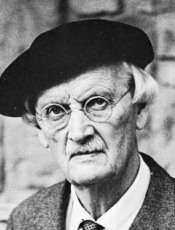
Jean Felix Piccard dies
On this day Jean-Felix Piccard a Swiss pioneer balloonist, died in Minneapolis on his 79th birthday. He was born on 28 January 1884. Twin brother of August Piccard, Jean-Felix made his first flight in 1913. Other missions on which he participated include the August 18, 1934, flight in the balloon Century of Progress from Dearborn, Michigan, to an altitude of 57,579 ft and on October 23 that same year with his wife he made the first successful stratospheric flight through clouds, ascending to a height of 11 miles (18 km).
During summer of 1936, he developed and flew first constant-level balloons made of cellophane from the University of Minnesota. In 1937, he made an ascent of 11,000 feet (3,350 m) to test a metal gondola attached to a cluster of 98 balloons. He also developed a frost-resistant window for balloon gondolas and an electronic system for emptying ballast bags.
He is generally credited with the development of polyethilene balloons for Navy's Project Helios which led to widespread use of plastic balloons as research tools in project like Skyhook, James A. Van Allen's Rockoons (balloon-launched sounding rockets), Strato-Lab, and Man High balloon research projects. -
January 30 2015
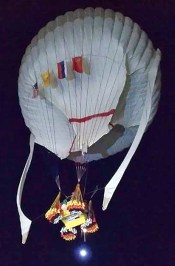
Bradley - Tiukhtyaev crossed the Pacific in the Two Eagles balloon
On this day in 2015, the Two Eagles balloon piloted by Troy Bradley (USA) and Leonid Tiukhtyaev (Russia) which was launched from Japan six days before, completed its record setting mission with a landing in the water near Baja California, Mexico. The mission's goal was double: to cross the Pacific Ocean to North America and to beat the official distance and duration records for gas balloons. The project's name honoured two other historical balloon missions: the transatlantic Double Eagle II and the transpacific Double Eagle V.
The flight was started from the japanese city of Saga, on the night of January 24, 2015 and ended four miles off the coast of Baja California in Mexico on January 30, 2015. The pilots were rescued by a fishing boat that same day and taken to shore safely.
The distance traveled by Two Eagles was of 6.646 miles (10.696 km) surpassing the existing record of 5,208 miles (8,383 km), set by Double Eagle V pilots Ben Abruzzo, Larry Newman, Ron Clark, and Rocky Aoki in 1981. The duration of the flight was 160 hours, 38 minutes (6 days, 16 hours, 38 minutes), beating the previous record of 137 hours, 5 minutes, 50 seconds set in 1978 by Ben Abruzzo, Maxie Anderson, and Larry Newman aboard the Double Eagle II.
Nowadays the capsule is at permanent display in the Anderson Abruzzo Albuquerque International Balloon Museum in New Mexico.

